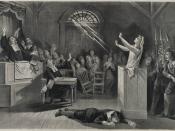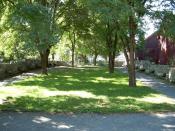HISTORY OF SALEM Salem is a well-known and historical town in Massachusetts. In 1630, there was a pioneer village that was located in Salem. In 1692-1693, the very famous and historical Salem Witch Trials took place. Both of these examples make Salem the place that it is today. The Salem Pioneer Village was originally in Dorchester. In 1626 less than 30 men abandoned their fishing village at Cape Ann and moved to Naumkeag or Salem. The new village consisted of the saw pit and frame, dugout hovels, the Brackenbury Wigwam, fish drying racks, the Palfrey House, the blacksmiths forge, the Connate House, the Governors Faire House, and the Woodbury House. Saw pits were tools that were used to saw boards from logs. The log would be squared off with an ax and then moved to the top of the frame where the sawyer would scribe lines along the log length.
These lines were used as a guide. The sawyer would stand on top of the log being helped by a pitman (the person standing below the log). They would use a two-handled saw. The sawyer would pull the saw up, and the pitman would pull the saw down. A dugout hovel was the place where the settlers lived during the first years to ensure that they had shelter. These dugout hovels helped them and their animals survive the harsh New England winters. These dugout hovels were abandoned once a permanent house was built. The Brackenbury wigwam was where the Brackenbury family lived. Wigwams were based on the structure of the Native American Wetu. It was made from bent green saplings and was covered with Norfolk reed. The outside of the wigwam was thatched with cattail reeds. Fishing was a big part of the lives of the settlers in Salem. Codfish were caught with hook and line, cleaned, split, salted, and then placed on racks to dry. When the fish were dry they could be packed in barrels and sent back to England because the waters there had been over-fished. The money that was received from England was used to buy supplies that could not be made in New England. The Palfrey House was a typical one-room house. It had a loft that was used for storage above the main room. Peter Palfrey; his wife Edith and his son Jonathan lived here. The first blacksmith arrived from England in 1631. The blacksmiths forge was where he made the tools needed in the village. He had to import the iron needed from England and spent lost of his time making and repairing tools. In the Connate House lived Roger, his wife Sarah, and children Caleb, Lot, Roger, and Sarah. Connate encouraged many of the people from Worcester to move to Salem. The Governor House was originally located in England. From there it was taken in pieces and erected in Cape Ann sometime before 1626. The house stayed here when the people moved to Salem. John Endicott arrived in New England in 1628 and had the house moved to Salem for his dwelling house. John Woodbury and his wife Agnes occupied the Woodbury House in 1626. John lived here until Roger Connate sent him back to England. He later returned with his son Humphrey and the new Governor, John Endicott, in 1628. The Pioneer Village still stands in Salem today as a recreation of the original village. Tools are still made and repaired here, and they try to give tourists some insight into the lives of the people that once lived there.
Salem is also well known for the witch trials that took place there in 1692-1693. During these two years, nineteen innocent people were hung; one was pressed to death, and as many as seventeen died in jail. They were all accused of practicing witchcraft. It all started when Reverend Parris; niece Abigail, his daughter Betty and some of the other girls in the town wanted to have their fortunes read by Reverend Parris; servant Tituba. Betty saw a coffin and started screaming at night and stopped talking. Then the other girls started screaming out in church. It came to be said that the girls were under the influence of the Devil. The girls then started naming people and saying that they saw the person with the devil. The girls would also say that the people that they were naming were hurting them in some way. To try to cure the girls, Reverend Parris had prayer services and community fastings conducted. He wanted to reveal what was plaguing the girls. Also in an effort to bring out the witches, John Indian, Titubas husband, baked a witch cake that was made of rye mean and the afflicted girls; urine. The cake was supposed to reveal the identities of the "witches" to the girls.
The girls were pressured into identifying the source of their affliction. Therefore they named three women. These women were Tituba, Sarah Good, and Sarah Osborn. Sarah Good and Sarah Osborn said that they were innocent of the charges against them, but Tituba confessed to seeing the devil. Tituba also said that there were more witches in Salem. Eight months after the strange occurrences started happening in Salem, a letter was written to the Governor about the trials that were going on. This letter is relating the problems of Salem to things that happened in Sweden thirty years before. It is also saying that the unnatural things that are going on could be false. A second letter was written just over four months after the first letter was written. This letter is telling about a new way that the Court was being run. The court was the Court of Oyer and Terminer now. Many of the people that were condemned at this time were thought to be innocent and many people were dissatisfied with the courts proceedings. The letter also states that the Devil was taking the shape of innocent people, and that the person writing this letter believed these accused people to be innocent.
On October 29th, the Court of Oyer and Terminer was dissolved. On November 25th, the General Court of the colony created the Superior Court to try the rest of the witchcraft cases. These trials took place in May of 1693. The afflicted persons were not allowed to be present at these trials. No one tried in the Superior Court was convicted of practicing witchcraft.
People being accused of practicing witchcraft finally stopped after the Governors wife was accused by the afflicted. The only problem with this was that the truth came out too late. More than twenty innocent peoples; lives were ruined or lost because of these lies. It was not just the people accused who suffered. It was their friends and families too. The people whose lives were lost during this time will never be forgotten. Also, this time in history will be remembered forever and thought upon to try to find reasons for these happenings.





